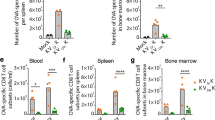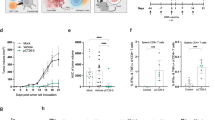Abstract
In a prior report (Int J Cancer 2006; 119: 339–348), we described a new vaccination strategy for squamous cell carcinoma (SCC). The vaccine was prepared by transfer of unfractionated DNA-fragments (25 kb) from KLN205 cells, a squamous carcinoma cell line (DBA/2 origin; H-2d) into LM cells, a highly immunogenic mouse fibroblast cell line (C3H/He origin; (H-2k)). As only a small proportion of the transfected cell population was expected to have incorporated DNA segments that included genes specifying antigens associated with the squamous carcinoma cells, we devised a novel strategy to enrich the vaccine for immunotherapeutic cells. Enhanced immunity to squamous carcinoma was induced in tumor-bearing mice treated solely by immunization with the enriched vaccine, which translated into prolonged survival without toxicity. Here, we describe the characteristics of the cell populations infiltrating established squamous carcinomas undergoing regression in mice immunized with vaccines enriched for immunotherapeutic cells. The results indicated that CD8+ T cells were predominant and that T-regulatory cells (FoxP3+, CD4/CD25+, CD4/CD62Lhigh, CD4/CTLA-4e) were relatively deficient in the regressing tumors. Inflammatory infiltrates were not detected in various organs and tissues of mice immunized with the DNA-based vaccine.
This is a preview of subscription content, access via your institution
Access options
Subscribe to this journal
Receive 12 print issues and online access
$259.00 per year
only $21.58 per issue
Buy this article
- Purchase on Springer Link
- Instant access to full article PDF
Prices may be subject to local taxes which are calculated during checkout




Similar content being viewed by others
References
Whiteside TL . Immune suppression in cancer: effects on immune cells, mechanisms and future therapeutic intervention. Semin Cancer Biol 2006; 16: 3–15.
Meissner M, Reichert TE, Kunkel M, Gooding W, Whiteside TL, Ferrone S et al. Defects in the human leukocyte antigen class I antigen processing machinery in head and neck squamous cell carcinoma: association with clinical outcome. Clin Cancer Res 2005; 11: 2552–2560.
Whiteside TL . Immunobiology of head and neck cancer. Cancer Metastasis Rev 2005; 24: 95–105.
Ferris RL . Progress in head and neck cancer immunotherapy: can tolerance and immune suppression be reversed? ORL J Otorhinolaryngol Relat Spec 2004; 66: 332–340.
Bas M, Bier H, Schirlau K, Friebe-Hoffmann U, Scheckenbach K, Balz V et al. Gamma-delta T-cells in patients with squamous cell carcinoma of the head and neck. Oral Oncol 2006; 42: 691–697.
Di Pucchio T, Pilla L, Capone I, Ferrantini M, Montefiore E, Urbani F et al. Immunization of stage IV melanoma patients with Melan-A/MART-1 and gp100 peptides plus IFN-alpha results in the activation of specific CD8(+) T cells and monocyte/dendritic cell precursors. Cancer Res 2006; 66: 4943–4951.
Slingluff Jr CL, Engelhard VH, Ferrone S . Peptide and dendritic cell vaccines. Clin Cancer Res 2006; 12: 2342–2345.
Lee WC, Wang HC, Hung CF, Huang PF, Lia CR, Chen MF . Vaccination of advanced hepatocellular carcinoma patients with tumor lysate-pulsed dendritic cells: a clinical trial. J Immunother 2005; 28: 496–504.
Hus I, Rolinski J, Tabarkiewicz J, Wojas K, Bojarska-Junak A, Greiner J et al. Allogeneic dendritic cells pulsed with tumor lysates or apoptotic bodies as immunotherapy for patients with early-stage B-cell chronic lymphocytic leukemia. Leukemia 2005; 19: 1621–1627.
Rosell R, Cecere F, Cognetti F, Cuello M, Sanchez JM, Taron M et al. Future directions in the second-line treatment of non-small cell lung cancer. Semin Oncol 2006; 33: S45–S51.
Mu LJ, Kyte JA, Kvalheim G, Aamdal S, Dueland S, Hauser M et al. Immunotherapy with allotumour mRNA-transfected dendritic cells in androgen-resistant prostate cancer patients. Br J Cancer 2005; 93: 749–756.
Ribas A . Genetically modified dendritic cells for cancer immunotherapy. Curr Gene Ther 2005; 5: 619–628.
Cuadros C, Dominguez AL, Lollini PL, Croft M, Mittler RS, Borgstrom P et al. Vaccination with dendritic cells pulsed with apoptotic tumors in combination with anti-OX40 and anti-4-1BB monoclonal antibodies induces T cell-mediated protective mmunity in Her-2/neu transgenic mice. Int J Cancer 2005; 116: 934–943.
Dunn G, Oliver KM, Loke D, Stafford ND, Greenman J . Dendritic cells and HNSCC: a potential treatment option? Oncol Rep 2005; 13: 3–10.
Wang HH, Mao CY, Teng LS, Cao J . Recent advances in heat shock protein-based cancer vaccines. Hepatobiliary Pancreat Dis Int 2006; 5: 22–27.
Zeng Y, Graner MW, Katsanis E . Chaperone-rich cell lysates, immune activation and tumor vaccination. Cancer Immunol Immunother 2006; 55: 329–338.
O-Sullivan I, Kim TS, Chopra A, Cohen EP . Therapeutic properties of DNA-based fibroblast and dendritic cell vaccines in mice with squamous carcinoma. Anticancer Res 2006; 26: 873–884.
Chopra A, Kim TS, O-Sullivan I, Martinez D, Cohen EP . Treatment of squamous carcinoma in mice with a vaccine enriched for cells that induce immunity to squamous carcinoma – a new vaccination strategy. Int J Cancer 2006; 119: 339–348.
Kim TS, Cohen EP . Immunity to breast cancer in mice immunized with fibroblasts transfected with a cDNA expression library derived from small numbers of breast cancer cells. Cancer Gene Ther 2005; 12: 890–899.
Whiteside TL, Gambotto A, Albers A, Stanson J, Cohen EP . Human tumor-derived genomic DNA transduced into a recipient cell induces tumor-specific immune responses ex vivo. Proc Natl Acad Sci USA 2002; 99: 9415–9420.
Sondak VK, Sabel MS, Mule JJ . Allogeneic and autologous melanoma vaccines: where have we been and where are we going? Clin Cancer Res 2006; 12: 2337s–2341s.
Errington F, Bateman A, Kottke T, Thompson J, Harrington K, Merrick A et al. Allogeneic tumor cells expressing fusogenic membrane glycoproteins as a platform for clinical cancer immunotherapy. Clin Cancer Res 2006; 12: 1333–1341.
Cheong SC, Blangenois I, Franssen JD, Servais C, Phan V, Trakatelli M et al. Generation of cell hybrids via a fusogenic cell line. J Gene Med 2006; 8: 919–928.
Palmowski MJ, Gileadi U, Salio M, Gallimore A, Millrain M, James E et al. Role of immunoproteasomes in cross-presentation. J Immunol 2006; 177: 983–990.
Donohue KB, Grant JM, Tewalt EF, Palmer DC, Theoret MR, Restifo NP et al. Cross-priming utilizes antigen not available to the direct presentation pathway. Immunology 2006; 119: 63–73.
Wigler M, Pellicer A, Silverstein S, Axel R, Urlaub G, Chasin L . DNA-mediated transfer of the adenine phosphoribosyl transferase locus into mammalian cells. Proc Natl Acad Sci USA 1979; 76: 1373–1376.
Sakaguchi S, Fukuma K, Kuribiashi K, Masuda T . Organ specific autoimmune disease induced in mice by elimination of T cell subsets. I. Evidence for the active participation of T cells in natural self-tolerance: deficit of a subset as possible cause of autoimmunity. J Exp Med 1985; 161: 72–87.
Sakaguchi S, Sakaguchi N, Asano M, Itoh M, Toda M . Immunologic self tolerance maintained by activated T cells expressing IL-2 receptor α chain (CD25). Breakdown of a single mechanism of self-tolerance causes various autoimmune diseases. J Immunol 1995; 155: 1151–1164.
Berendt MJ, North RJ . T cell mediated suppression of anti tumor immunity. An explanation for progressive growth of an immunogenic tumor. J Exp Med 1980; 151: 69–80.
North RJ . Down regulation of the anti tumor immune response. Adv Cancer Res 1985; 45: 1–43.
Mukherji B, Wilhelm SA, Guha A, Ergin MT . Regulation of cellular immune response against autologous human melanoma. I. Evidence for cell mediated suppression of in vitro cytotoxic immune response. J Immunol 1986; 136: 1888–1892.
Terabe M, Berzofsky JA . Immunoregulatory T cells in tumor immunity. Curr Opin Immunol 2004; 16: 157–162.
Hori S, Nomura T, Sakaguchi S . Control of regulatory T cell development by the transcription factor FoxP3. Science 2003; 299: 1057–1061.
Fontenot JD, Rasmussen JP, Williams LM, Dooley JL, Farr AG, Rudensky AV . Regulatory T cell-lineage specification by the forkhead transcription factor FoxP3. Immunity 2005; 22: 329–341.
Kim TS, Jung MY, Cho D, Cohen EP . Prolongation of the survival of breast cancer-bearing mice immunized with GM-CSF-secreting syngeneic/allogeneic fibroblasts transfected with a cDNA expression library from breast cancer cells. Vaccine 2006; 24: 6564–6573.
Wang W, Epler J, Salazar LG, Riddell SR . Recognition of breast cancer cells by CD8+ cytotoxic T-cell clones specific for NY-BR-1. Cancer Res 2006; 66: 6826–6833.
Jemal A, Tiwari RC, Murray T, Ghafoor A, Samuels A, Ward E et al. American Cancer Society. Cancer Statistics, 2004. CA Cancer J Clin 2004; 54: 8–29.
Forastiere A, Koch W, Trotti A, Sidransky D . Head and neck cancer. N Eng J Med 2001; 345: 1890–1900.
Murphy GP, Lawrence W, Lenhhartd RE . Am Cancer Soc. Textbook of Clinical Oncology. 2nd edn. American Cancer Society: Atlanta, 1995.
Colnot DR, Quak JJ, Roos JC, de Bree R, Wilhelm AJ, Snow GB et al. Radioimmunotherapy in patients with head and neck squamous cell carcinoma: initial experience. Head Neck 2001; 23: 559–565.
Kuriakose MA, Chen FA, Egilmez NK, Jong YS, Mathiowitz E, DeLacure MD et al. Interleukin-12 delivered by biodegradable microspheres promotes the antitumor activity of human peripheral blood lymphocytes in a human head and neck tumor xenograft/SCID mouse model. Head Neck 2000; 22: 57–63.
Cortesina G, De Stefani A, Sacchi M, Rosso S, Galeazzi E . Immunomodulation therapy for squamous cell carcinoma of the head and neck. Head Neck 1993; 15: 266–270.
Kim TS, Chopra A, O-Sullivan IS, Cohen EP . Enhanced immunity to breast cancer in mice immunized with fibroblasts transfected with a complementary DNA expression library from breast cancer cells: Enrichment of the vaccine for immunotherapeutic cells. J Immunother 2006; 29: 261–273.
Chopra A, Kim TS, O-Sullivan I, Martinez D, Cohen EP . Combined therapy of an established, highly aggressive breast cancer in mice with paclitaxel and a unique DNA-based cell vaccine. Int J Cancer 2006; 118: 2888–2898.
Shimizu J, Yamazaki S, Sakaguchi S . Induction of tumor immunity by removing CD25+CD4+ T cells: a common basis between tumor immunity and autoimmunity. J Immunol 1999; 163: 5211–5218.
Gallimore A, Sakaguchii S . Regulation of tumor immunity by CD25+ T cells. Immunology 2002; 107: 5–9.
Wei-Zen W, Morris GP, Kong Yi-chi M . Anti tumor immunity and autoimmunity: a balancing act of regulatory T cells. Cancer Immunol Immunother 2004; 53: 73–78.
Tanaka H, Tanaka J, Kjaergaard J, Shu S . Depletion of CD4+CD25+ regulatory cells augments the generation of specific T cells in tumor-draining lymph nodes. J Immunother 2002; 25: 207–217.
Antony PA, Piccrillo CA, Akpinarli A, Finkelstein SE, Speiss PJ, Surman DR et al. CD8+ T cell immunity against a tumor/self antigen is augmented by CD4+ T helper cells and hindered by naturally occurring T regulatory cells. J Immunol 2005; 174: 2591–2601.
Zhou G, Drake CG, Levitsky HI . Amplification of tumor-specific regulatory T cells following therapeutic cancer vaccines. Blood 2006; 107: 628–636.
Hiura T, Kagamu H, Miura S, Ishida A, Tanaka H, Tanaka J et al. Both regulatory T cells and anti tumor effector cells are primed in the same draining lymph nodes during tumor progression. J Immunol 2005; 175: 5058–5066.
Acknowledgements
This work was supported by NIDCR Grant number 1 RO1 DEO13970-O1A2 awarded to Dr Cohen. The use of animals in these studies as reviewed and approved by the Animal Care Committee of the University of Illinois (Approval number 04-067, expires 7/07).
Author information
Authors and Affiliations
Corresponding author
Rights and permissions
About this article
Cite this article
Chopra, A., O-Sullivan, I., Carr, J. et al. T-regulatory cells are relatively deficient in squamous carcinomas undergoing regression in mice immunized with a squamous carcinoma vaccine enriched for immunotherapeutic cells. Cancer Gene Ther 14, 573–582 (2007). https://doi.org/10.1038/sj.cgt.7701040
Received:
Revised:
Accepted:
Published:
Issue Date:
DOI: https://doi.org/10.1038/sj.cgt.7701040



